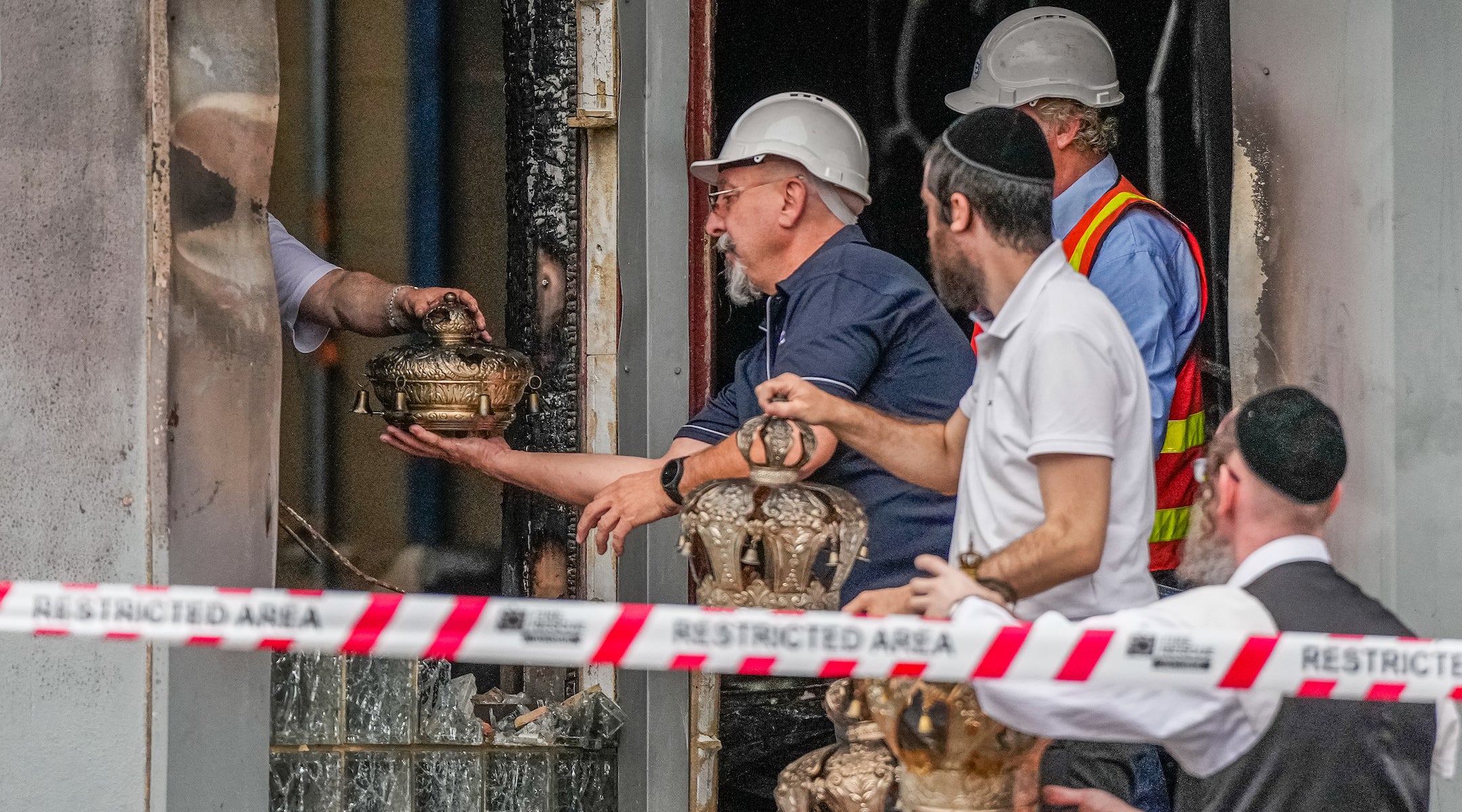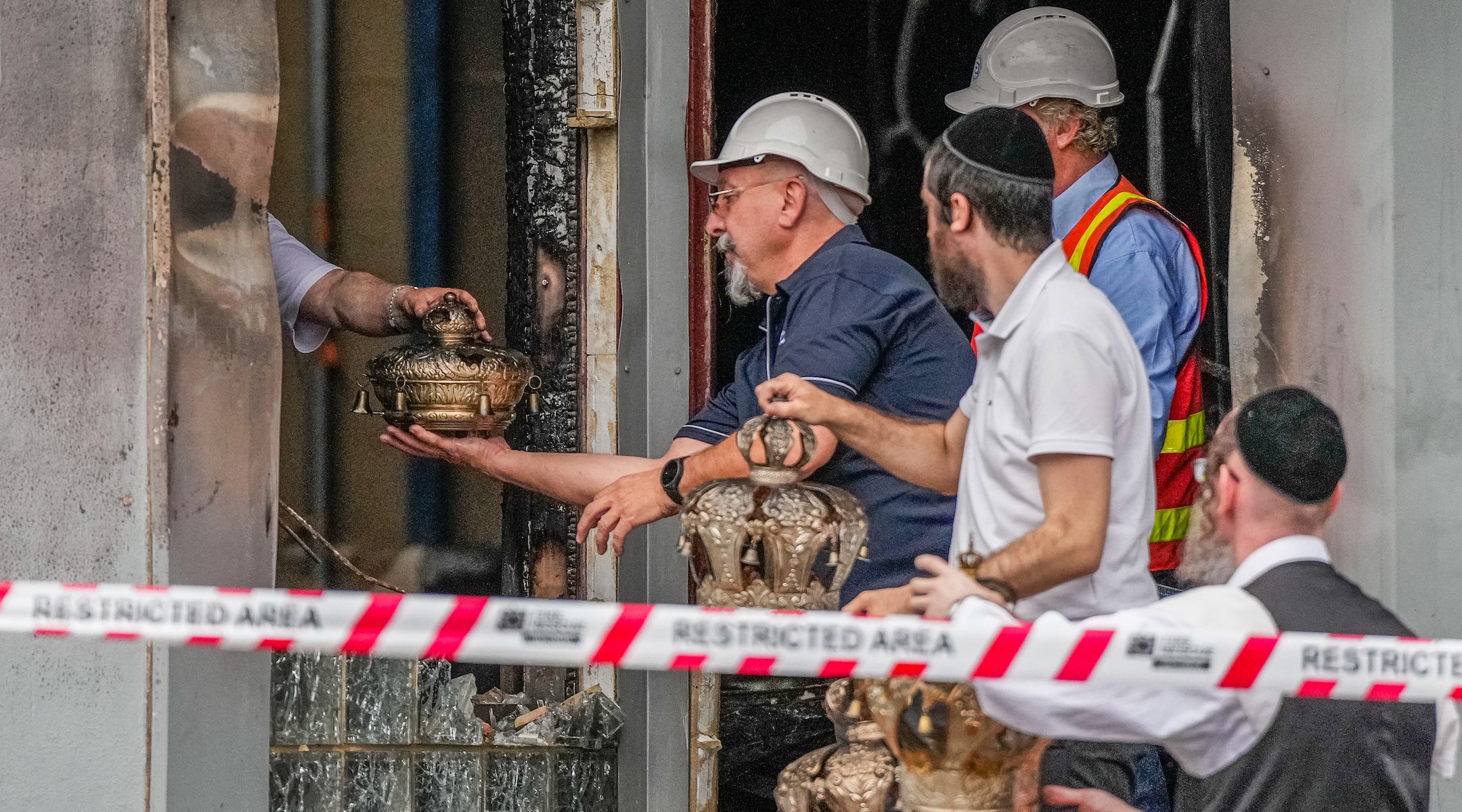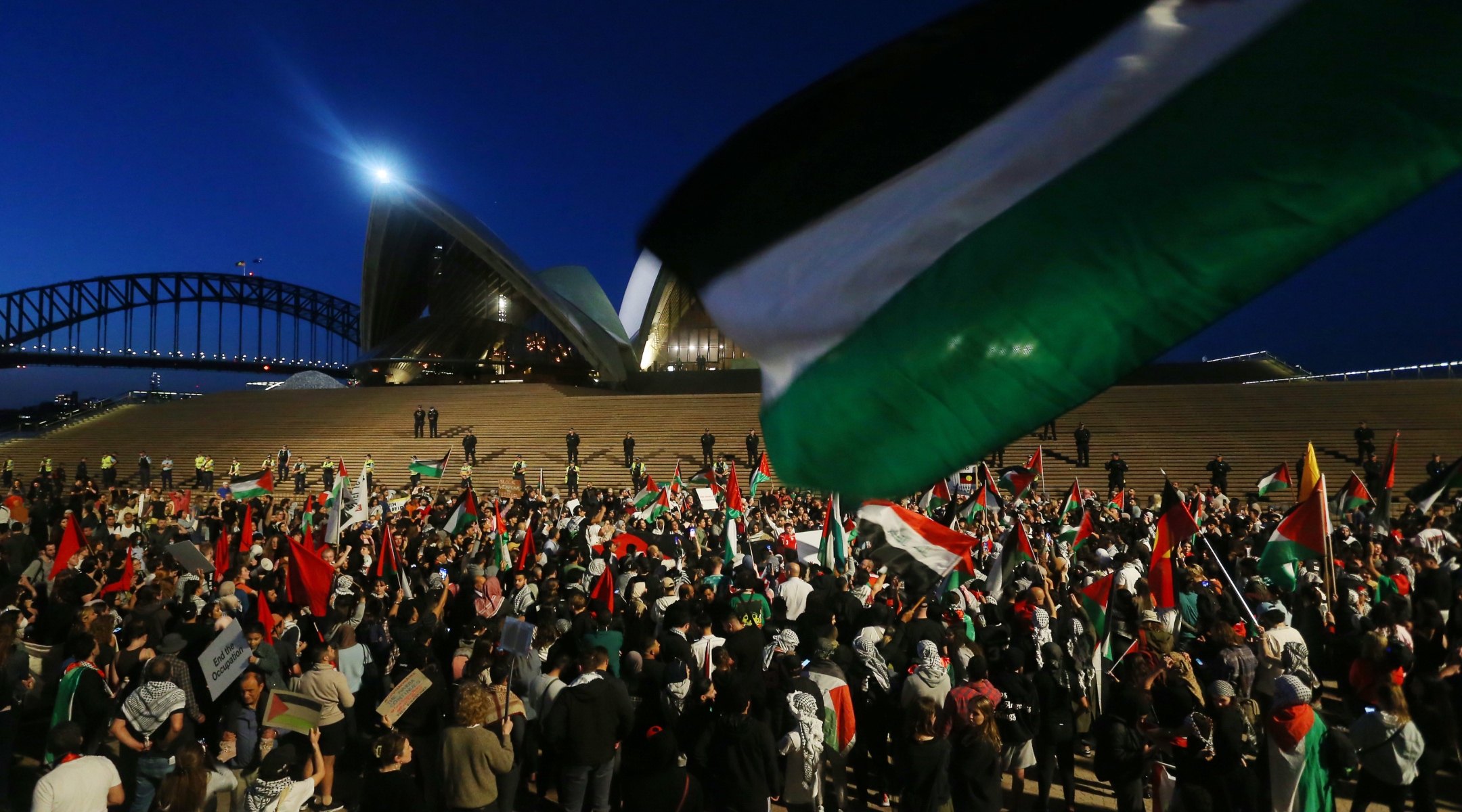Uncategorized
A groundbreaking ex-Hasidic memoir is now an opera
(New York Jewish Week) — As a Hasidic mom raising a family in Houston, Leah Lax had seven children ages 9 and under — including an infant, and a toddler with health issues, born just 11 months apart. When she found herself unexpectedly pregnant again, she realized she needed to have an abortion.
That scene — and the ensuing conflict with her husband, who viewed abortion as murder — is an emotional climax in “Uncovered: A Chamber Opera in One Act,” which is based on Lax’s acclaimed memoir, “Uncovered: How I Left Hasidic Life and Finally Came Home.” When the book was published in 2015, the New York Jewish Week called it “the first ex-Hasidic gay memoir.”
Produced by City Lyric Opera, it opens Wednesday at Manhattan’s HERE Arts Center, and runs through Saturday night.
Raised in a secular Jewish family, Lax connected with the Chabad Hasidic movement at age 16 and married a grad student when she was 19. Today, Lax, 66, still lives in Houston, but with her wife, with whom she has been partnered for 17 years. Her children — some of whom have remained religious and some who have not — are spread around the country. Lax has 13 grandchildren “and counting,” she says with audible delight.
Lax wrote the libretto for “Uncovered,” as she has for other operas; the music was composed by Lori Laitman. Lax’s next book, “Not From Here,” is based on a libretto she wrote for Houston Grand Opera for which she spent a year interviewing dozens of refugees and immigrants in the Texas city. It is slated for publication in summer 2023 by Pegasus Press. Interviewing those people led Lax to realize that she felt like an immigrant to her own life, she said.
Lax and I have known each other since I reviewed the book “Uncovered” shortly after publication.
This interview was lightly edited for length and clarity.
New York Jewish Week: What did your eighth pregnancy represent?
Leah Lax: It was the wakeup call of my life. Before that I was inured to everything except following what I was expected to do. Before that my body didn’t belong to me. It belonged to God, and what is God? Halacha [Jewish law] is the voice of God.
Then I realized that this pregnancy could kill me. My body was telling me something that nobody else was hearing, and I realized that I am the authority of my body. I decided to get an abortion. When I told my husband it sparked a huge crisis. He said “If you do, I will divorce you.” To soothe him, I said let’s ask a rav [a rabbi]. I knew I would do it anyway, but if a rav said yes I wouldn’t be out on the street or lose my children [in a divorce]. The rav spoke to my doctor, who said he thought I was at risk. The rav came back and said, “You have to do this thing and do not speak of it to anyone.” Today Christian values have taken over the abortion issue and it really is stomping on our freedom of religion. [Most Jewish sources do not consider that life begins at conception, and Jewish tradition allows room to prioritize the life of the mother when there is a danger to her physical or emotional health.]
I had the abortion, but it came between my husband and me. He grieved and would not speak of it. I was alone with my secret. But I was awake. I changed. That’s when I started writing. It set off a process that led me out the door.
You stayed in Houston, where you raised your family. What was it like to come out as gay and non-religious there?
I was having an affair with a woman. The whole community figured it out and erupted in gossip. I was followed. There’s a confrontation scene in the opera about it. I crossed town to be with my lover and didn’t come out formally until I moved out of the house and left the community. The community shunned me to the point where I began grocery shopping on Saturdays to avoid people. I had been the first- and third-grade teacher at their Chabad day school, and I lost those relationships. Now I’ve reconciled with many of them.
What impact did the publication of “Uncovered” have?
It caused tension with some of my religious kids. They were OK with our differences as long as it was private. Putting it in print, that radical freedom of speech was a departure for them. I really seek to heal that — we have, to some extent. Being an artist is an act of radical free speech. Artists are dangerous people. If I had it to do over again, I would talk it through with my children in advance. I didn’t know to prepare them for it, and I don’t know if it would have helped.
Writing it, I had to delve into memories and keep renewing that story. I became a person living both my past and present. It moved me forward. It led into the next project, “Not From Here: The Song of America,” this awareness of the past and how it forms us.
What do you want viewers to take away from “Uncovered” the opera?
I want my work to break down religious walls. I want people to find through this work that these issues that are looked as abstract by movements are personal and individual, whether it’s abortion, sexuality or religious choice. It is within us, or between us and God.
“Uncovered” runs at the HERE Arts Center, 145 Sixth Ave. Wednesday-Friday, Nov. 16-18, 8:30 p.m.; Saturday, Nov. 19, 4:00 p.m.; Saturday, Nov. 19, 8:30 p.m. $35. Get ticket information here.
—
The post A groundbreaking ex-Hasidic memoir is now an opera appeared first on Jewish Telegraphic Agency.
Uncategorized
U.S. leaders condemn ‘vile act of antisemitic terror’ after deadly Hanukkah attack in Australia
American politicians responded early Sunday to devastating reports from Sydney, Australia, where at least 11 people were killed during a Hanukkah celebration at the popular Bondi Beach on the first night of Hanukkah. Australian Prime Minister Anthony Albanese called the terror attack an “act of evil antisemitism” that targeted Australia’s Jewish community.
Some elected officials struck a somber tone, while others drew political conclusions.
Secretary of State Marco Rubio issued a brief statement condemning the attack and said that “antisemitism has no place in this world.”
Israeli Prime Minister Benjamin Netanyahu said on Sunday that the Australian government’s decision to recognize a Palestinian state earlier this year encouraged “the Jew-hatred now stalking your streets.”
Sen. Lindsey Graham, Republican of South Carolina, tied the attack to the Israel-Hamas war, sending a warning to governments that support the unilateral recognition of an independent Palestinian state before Hamas is disarmed. “When you appease those who kill Jews, you get more killing of Jews,” Graham said in an interview on Fox News’ Sunday Morning Futures.
Sen. John Fetterman, a pro-Israel Democrat from Pennsylvania, echoed that sentiment on the same program, saying that anti-Israel protests in recent years have “penetrated” into violent attacks on Jews. “Just call it what it is,” Fetterman said. “Antisemitism is a worldwide scourge, and it’s constantly demonstrated to be deadly.”
Senate Minority Leader Chuck Schumer, who is Jewish, posted on X that the attack is a “shocking reminder that antisemitism and hate is not only toxic and far too present and widespread around the world, it is deadly. It must be vigorously condemned, confronted and overcome.”
New York City Mayor-elect Zohran Mamdani issued a statement, posted on his social media accounts, calling the attack a “vile act of antisemitic terror” and “the latest, most horrifying iteration in a growing pattern of violence targeted at Jewish people across the world.”
Mamdani, an outspoken critic of Israel whose statements on the conflict and refusal to disavow the “globalize the Intifada” slogan have roiled and divided the Jewish community, said the deadly attack should be met with urgent action to counter antisemitism. He also reiterated his pledge to “work every day to keep Jewish New Yorkers safe — on our streets, our subways, at shul, in every moment of every day.” New York City is home to the largest concentration of Jews in the United States.
Outgoing New York City Mayor Eric Adams said the police department will provide additional security at public menorah lightings across the city. New York Gov. Kathy Hochul said the state police will assist with protection. “New York will always stand against the scourge of antisemitism and confront violence head-on,” Hochul added.
Brad Lander, the outgoing New York City Comptroller who is Jewish, and also running for Congress, also highlighted the heroism of a local man, Ahmed al-Ahmed, who put his own life at risk by running behind one of the gunmen and tackling and disarming him. Lander mourned the killing of a Chabad of Bondi’s Rabbi Eli Schlanger.
“Our menorahs tonight will also be yahrzeit candles — with grief for this grievous loss and rededication to shine brighter than slaughter and hate,” Lander wrote on X.
The post U.S. leaders condemn ‘vile act of antisemitic terror’ after deadly Hanukkah attack in Australia appeared first on The Forward.
Uncategorized
Timeline: How attacks on Jews in Australia have been growing since Oct. 7

The mass shooting at a Hanukkah celebration on Sydney’s Bondi Beach on Sunday marked a grim new chapter in a pattern Australian officials have been tracking for more than two years: the steady escalation of antisemitic threats, from harassment and vandalism to arson, attempted attacks on synagogues and, now, mass-casualty violence at a public Jewish gathering.
Police said at least 11 people were killed, including a rabbi, when a gunman opened fire on families celebrating the first night of Hanukkah at the Chabad event, known as “Chanukah by the Sea.” Federal and state leaders swiftly condemned the attack as antisemitic terrorism and pledged a full national security response.
For Australia’s Jewish community, which numbers around 100,000, the shooting shattered any remaining sense that the country’s recent antisemitic incidents — alarming as they were — remained largely isolated and contained. Some of those attacks, including the Dec. 2024 firebombing of a kosher restaurant and a firebombing of a Melbourne synagogue that same month, were linked to potential Iran involvement.
Sunday’s attack followed mounting warnings from law enforcement and Jewish organizations that antisemitism in Australia had entered a more dangerous phase since Hamas attacked Israel on Oct. 7, 2023 and the war in Gaza ensued.
Below is a timeline of major recent antisemitic incidents in Australia, as authorities and Jewish groups charted an intensifying threat.
July 2025
Australia’s antisemitism envoy reported a dramatic rise in attacks against Jews, citing more than 2,000 cases in the year following Oct. 7 — an increase of more than 300% compared with the previous year.
July 2025
A man set fire to the front door of a synagogue in Melbourne while congregants were inside for Shabbat dinner, as a separate group of protesters stormed an Israeli restaurant nearby. No one was injured in either attack, police said, adding that the synagogue fire was quickly extinguished and that one person was arrested after demonstrators chanting anti-Israel slogans disrupted the restaurant.
Feb. 2025
Two nurses at a Sydney hospital were arrested after they threatened to kill Israeli patients in a video that went viral. It was an episode officials described as emblematic of how antisemitic rhetoric had seeped into workplaces and public institutions.
Feb. 2025
Police in Melbourne arrested a man accused of scrawling antisemitic graffiti in a park and throwing a packet of bacon at a passerby who confronted him.
Feb. 2025
A cluster of incidents in Sydney’s southeast suburbs, home to a large Jewish community, raised alarm among authorities. Antisemitic graffiti was sprayed on cars, homes and on a Jewish elementary school.
Jan. 2025
Police discovered explosives in a camper van in Sydney, saying the device may have been intended for a mass-casualty attack targeting Jews. Police later revealed that the plot was an elaborate hoax masterminded by a crime boss.
Jan. 2025
Two synagogues in Sydney were vandalized on successive days with swastikas and other antisemitic slogans. The attacks also included a nearby home that was defaced with an anti-Jewish slur.
Dec. 2024
The Australian government formed a national antisemitism task force, signaling a shift toward treating antisemitic violence as a coordinated security threat rather than isolated hate crimes.
Dec. 2024

Arsonists firebombed an historic synagogue in Melbourne, causing congregants gathered for morning services to flee. At least one person was injured and the building suffered extensive damage.
In Aug. 2025, federal authorities announced charges in the case and said intelligence agencies were examining evidence of foreign-linked coordination. Officials publicly alleged Iranian involvement, escalating the case into a matter of international security, and expelled from the country Ambassador Ahmad Sadeghi and three other Iranian officials.
October 2024
On Bondi Beach, where the Dec. 2025 shooting took place, arsonists first attacked a brewery which they had incorrectly identified as a kosher caterer. They went back and set fire to the caterer’s building a few days later. Authorities eventually revealed they thought the attacks were done at the behest of Iran. That same month, antisemitic graffiti appeared on a Jewish bakery in Sydney.
May 2024
Vandals sprayed antisemitic graffiti on a Jewish school in Melbourne. School officials increased security amid concerns about copycat attacks.
Feb. 2024
Pro-Palestinian activists made public the personal details of hundreds of Jewish academics, artists and professionals who had participated in a private WhatsApp group. The leak triggered a wave of harassment, prompting at least one family to go into hiding. The episode drew condemnation from federal leaders and warnings from police that online targeting could translate into real-world violence.
Dec. 2023
The Executive Council of Australian Jewry reported a sharp spike in antisemitic incidents in the weeks following Oct. 7, including threats, harassment, vandalism and intimidation. The increase prompted expanded security at synagogues, schools and community centers across major cities.
Nov. 2023
A Melbourne synagogue was ordered to evacuate during Friday night Shabbat services as police responded to nearby pro-Palestinian demonstrations. About 150 congregants had gathered at Central Shul in Caulfield when authorities advised them to leave as a precaution.
Oct. 2023

Two days after Hamas’ Oct. 7 attack on Israel, the Sydney Opera House was lit up in the colors of the Israeli flag and was expected to draw Jews looking for a public space to mourn. Instead, it drew more than 1,000 pro-Palestinian protesters, some of whom spewed antisemitic slogans and rhetoric.
The post Timeline: How attacks on Jews in Australia have been growing since Oct. 7 appeared first on The Forward.
Uncategorized
Unarmed man who tackled Bondi Beach Hanukkah attacker identified as Ahmed al-Ahmed
(JTA) — Viral video circulating after the Bondi Beach Hanukkah attack showed an unarmed man racing toward one of the shooters and tackling him from behind before wrestling the gun from his hands.
The man has been identified as Ahmed al-Ahmed, the operator of a fruit stand in a Sydney suburb who happened to be in the area. He was shot twice but expected to survive.
“He is a hero, 100%,” a relative who identified himself as Mustafa told 7News Australia.
Chris Minns, the premier of New South Wales, the Australian state that includes Sydney, called the footage “the most unbelievable scene I’ve ever seen.”
He added, “That man is a genuine hero, and I’ve got no doubt that there are many, many people alive tonight as a result of his bravery.”
At least 11 people were killed during the attack on a Hanukkah celebration on Sunday night, with dozens of others injured.
The video shows al-Ahmed crouching behind a car before running up behind the shooter. After taking hold of the gun, al-Ahmed aims the attacker’s gun at him but not firing, as a second attacker fired on him from a nearby footbridge. No other first responders are visible in the video.
Moments after al-Ahmed takes hold of the long gun, a second person joins him. Then a man wearing a kippah and tzitzit, the fringes worn by religiously observant Jewish men, runs into the picture and toward the attacker, who is wearing a backpack. The Jewish man throws something at the attacker. The video does not make clear what was thrown or whether it hit its intended target.
After taking hold of the gun, al-Ahmed puts it down against a tree and raises his hand, apparently signaling that he is not a participant in the attack.
In his response to the attack, which killed a prominent Chabad rabbi among others, Prime Minister Anthony Albanese praised “everyday Australians who, without hesitating, put themselves in danger in order to keep their fellow Australians safe.” He added, “These Australians are heroes and their bravery has saved lives.”
The post Unarmed man who tackled Bondi Beach Hanukkah attacker identified as Ahmed al-Ahmed appeared first on The Forward.


